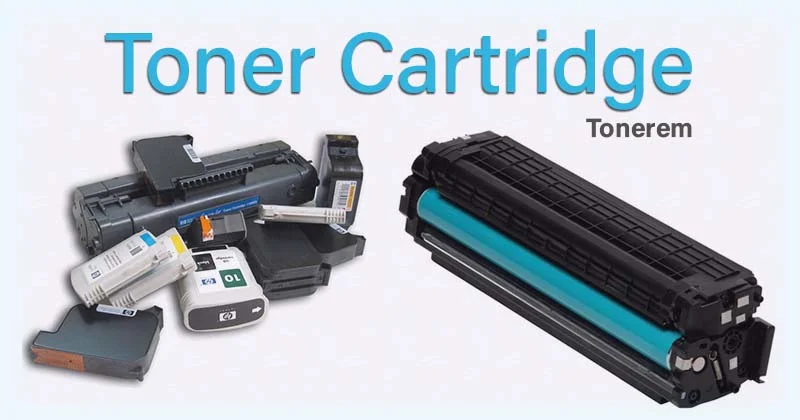Toner cartridge referred to as “tonerem”, are the consumable components that synonymous with laser printers. Toner cartridges are far more than simple ink holders; they are the unsung heroes responsible for crafting the sharp & crisp images, the text we see on paper.
This article gets into the details of toner cartridges, shedding light on their variants, pricing, page yields and the key differences between ink and toner.
The Anatomy of a Toner Cartridge
Toner cartridges are not just containers for toner powder; they are sophisticated components in their own right. These cartridges house a fine, dry mixture of plastic particles, carbon and black, which collaborate to create the actual images on paper.
The magic happens when the toner is transferred to paper via an electrostatically charged drum unit and then fused onto the paper by heated rollers during the printing process. Unlike ink cartridges, toner cartridges won’t stain your hands but they can get messy: if handled improperly.
Variants and Components
Toner cartridges are not one-size-fits-all; they come in different variations to suit various printing needs. Low-end to mid-range laser printers typically feature two consumable parts: the toner cartridge itself, which boasts a typical lifespan of 2,000 pages and the drum unit with a typical life of 40,000 pages.
Some toner cartridges incorporate the drum unit in their design, allowing for simultaneous replacement of both components, though this comes at a higher cost. Toner cartridges serve a similar function to ink cartridges used by inkjet printers.
Tonerem Pricing and Challenges
The price of toner cartridges from printer manufacturers can sometimes surpass the cost of the printer itself, especially in the case of the cheapest laser printers. These budget-friendly printers often come with cartridges containing significantly less toner than standard ones, resulting in more frequent replacements.
To combat this, many companies offer generic replacement toner cartridges at a fraction of the cost. These cartridges can be either new or re-manufactured.
Additionally, there are toner refill kits available, allowing users to recharge empty cartridges.
Page Yield and Standardization
Page yield is a crucial metric for toner cartridges, indicating the number of pages a tonerem can print. Manufacturers typically provide an estimated yield figure to give consumers an idea of what to expect.
However, for years, these yield figures varied significantly among manufacturers, making it challenging for consumers to compare products. In response, the International Organization for Standardization (ISO) published standardized yield standards for monochrome and color toner cartridges. These standards bring more consistency, though real-world usage can still differ considerably from ISO estimates.
Smart Chips and Environmental Concerns of Toner Cartridge
Some toner cartridges contain smart chips, similar to inkjet printers, which restrict the number of pages that can be printed. While this strategy aims to boost cartridge sales, it also generates more waste and environmental concerns. Reset devices can be employed to override the limitations set by these smart chips.
Interestingly, some laser printers assess toner levels using optical mechanisms rather than chips, rendering the chips pointless.
Cartridge Types
- OEM (Original Equipment Manufacturer): Cartridges produced by the printer manufacturer, often referred to as “genuine.” They are typically more expensive but come with assurances of quality.
- Compatible: These cartridges are manufactured by third-party companies and sold under various brand names. They are often cheaper but may vary in quality and reliability.
- Re-manufactured: Cartridges that have been refilled and refurbished, offering a cost-effective & environmentally friendly alternative.
Ink vs. Toner: Understanding the Difference
Ink and toner cartridges cater to different printing needs:
Ink Cartridges
- Contains liquid and are used in inkjet printers.
- Can be dye-based or pigment-based, with differences in durability and print quality.
- Suitable for home use, producing vibrant color prints but potentially prone to smudging and fading.
Toner Cartridges
- Contain dry powder and are used by laser printers.
- Do not stain, but can be messy if mishandled.
- Ideal for high-volume text printing, less suitable for photo printing due to tonal limitations.
Choosing the Right Printer
Selecting the right printer ultimately depends on your specific printing needs. Inkjet printers are favored by families, photographers and small home offices, especially, if you require quality photos and color prints.
Laser printers, on the other hand, are the go-to choice for high-volume text printing, ideal for small-medium businesses and schools. While photo printing is not their strong suit, color laser printers can add a pop of color to everyday documents.
Wrapping Up
In a world where information flows freely and choices abound, understanding the nuances of toner cartridges and printers can save you both time and money. Whether you’re printing cherished family photos or churning out reams of reports, knowing your ink from your toner is the first step in making the right printing choices.
Read More:



